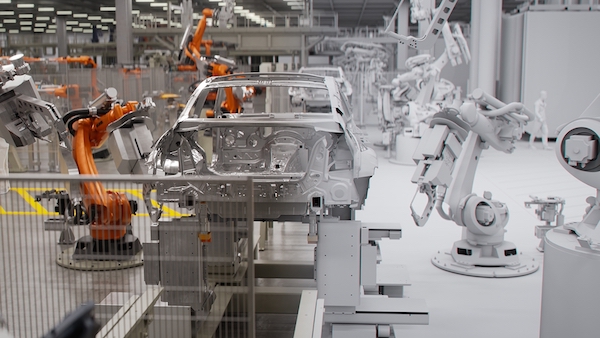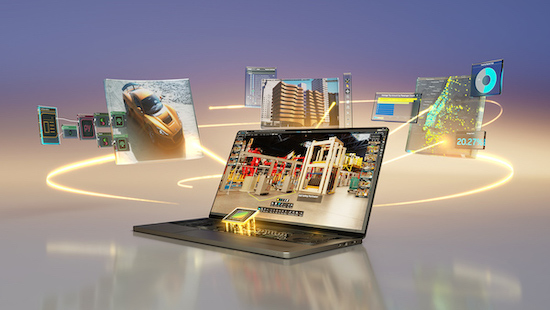
Carmaker BMW began production virtually in NVIDIA Omniverse. Image courtesy of NVIDIA & BMW.
Latest News
April 6, 2023
The importance of GPU acceleration and compute power was on display at the recent NVIDIA GTC 2023 conference in March. At the annual event, the company announced new capabilities and use cases for its Omniverse platform, showcased its new family of GPUs, and how its technologies will enable advanced artificial intelligence (AI) workflows.
NVIDIA GTC 2023, a virtual event exploring advancements in AI, accelerated computing, and industrial digitalization, drew an estimated 250,000 participants - a new attendance record, said NVIDIA CEO Jensen Huang.
GPU acceleration has gone mainstream, spreading from Excel and CFD to genomic sequencing. “Ansys, Siemens, Cadence, and other leading CFD solvers are now GPU accelerated,” said Huang in his virtual GTC keynote on March 21st.
Cadence Design Systems, highlighted in Huang’s keynote, is already a household name in electronics design and multiphysics simulation software.
“With Cadence’s CharLES CFD solver, accelerated by NVIDIA® CUDA®, at equivalent system cost, NVIDIA A100 Tensor Core GPU is nine times the throughput of CPU servers, or at equivalent simulation throughput, NVIDIA is nine times lower cost, or 17 times less energy consumed,” Huang pointed out.
Beyond product-level simulation, NVIDIA is also serving the market for system-level simulation with digital twins. To enable such applications, the company is bolstering its NVIDIA Omniverse platform.
“Omniverse is a platform for industrial digitalization that bridges digital and physical. It lets industries design, build, operate, and optimize physical products and factories digitally, before making a physical replica,” said Huang. Omniverse has been downloaded about 300,000 times, he reported.
BMW Virtual Production Underway
The costlier the physical prototype, the greater the digital twin’s appeal. For running what-if scenarios and simulating failure modes, doing it in pixels is less expensive than conducting destructive physical tests. That may explain why automakers have embraced NVIDIA’s Omniverse as a place for their digital twins.
“For next generation Mercedes Benz and Jaguar Land Rover vehicles, engineers use NVIDIA DRIVE Sim™ in Omniverse, to generate synthetic data to train AI models, validate the active safety system against the virtual driving test, and simulate real driving scenarios … Working with [logistic and transport software maker] Idealworks, BMW uses NVIDIA Isaac Sim and Omniverse to generate synthetic data and scenarios to train factory robots,” Huang pointed out.
BMW has already begun a global rollout of Omniverse-hosted virtual factories. In conjunction with GTC, the carmaker announced, “More than two years before the official launch of series production, vehicle manufacturing is already underway in the future plant Debrecen—virtually, at least, as Debrecen is the BMW Group’s first facility to be planned and validated completely virtually.” (You can see a demo here.)
This could set precedence for other carmakers and manufacturers, to plan and test out production activities in digital replicas before the metal cutting begins. BMW said it is “taking a digital-first approach to validate and optimize complex manufacturing systems across its production network using NVIDIA Omniverse Enterprise.”
Cloud Partners for Omniverse
To support an expanding set of industrial use cases and workflows, NVIDIA is offering NVIDIA Omniverse Cloud, built on Microsoft Azure. Think of it as a development platform enabling enterprises and developers to unlock industrial digitalization, offered via a PaaS model.
.png)
“Microsoft Azure will host two new cloud offerings from NVIDIA: NVIDIA Omniverse Cloud, a platform-as-a-service giving instant access to a full-stack environment to design, develop, deploy, and manage industrial metaverse applications; and NVIDIA DGX™ Cloud, an AI supercomputing service that gives enterprises immediate access to the infrastructure and software needed to train advanced models for generative AI and other groundbreaking applications,” announced NVIDIA.
CAD and simulation software users can work with Omniverse via connectors, developed by NVIDIA and its partners. The latest additions to the growing list of connectors come from, among others, Siemens, Rockwell Automation, and Unity.
New GPUs Accelerate Design, Visualization Performance
At the conference NVIDIA announced six new NVIDIA RTX™ GPUs for laptops and desktops based on Ada Lovelace architecture that the company says can enhance the performance of workstations for AI, design, simulation, and metaverse applications.
The NVIDIA RTX™ 5000, NVIDIA RTX™ 4000, NVIDIA RTX™ 3500, NVIDIA RTX™ 3000, and NVIDIA RTX™ 2000 Ada Generation laptop GPUs deliver improved performance and up to 2x the efficiency of the previous generation. For the desktop, the NVIDIA RTX™ 4000 SFF (small form factor) Ada Generation GPU features new RT Cores, Tensor Cores and CUDA cores with 20GB of graphics memory to deliver incredible performance in a compact card.

NVIDIA’s new laptop GPUs deliver up to double the performance and power efficiency over the previous generation for mobile workstations, the company says.
Next-generation workstations featuring the new NVIDIA RTX GPUs will be available from partners like Dell Technologies later this year.
Hardware to Boost Natural Language
Lately, the AI-driven chatbot ChatGPT, developed by OpenAI, has ignited new enthusiasm for AI-powered apps that can simplify complex tasks, from research to programming. Huang, a long-time AI advocate, called ChatGPT “the AI heard around the world.”
In his keynote, he said, “A new computing platform has been invented. The iPhone moment of AI has started. Accelerated computing and AI have arrived.” This is good news for NVIDIA as the company’s offerings include the NVIDIA DGX H100, a GPU-accelerated system for processing AI workloads, available from hardware partners such as Dell.
“Half of the Fortune 100 companies have installed DGX AI supercomputers. DGX has become the essential instrument of AI. The GPU of DGX is eight H100 modules,” said Huang.
The NVIDIA® H100 Tensor Core GPUs are recommended for machine learning and training applications, such as natural language processing. They come with NVIDIA® NVLink™, allowing users to connect up to 256 H100 GPUs to tackle Exascale workloads.
Foundations for The New Era
NVIDIA announced the launch of NVIDIA AI Foundations Cloud Services, to “enable businesses to build, refine, and operate custom large language models and generative AI models that are trained with their own proprietary data and created for their unique domain-specific tasks,” according to the announcement.
“Enterprises can use the NVIDIA NeMo language service and the NVIDIA Picasso image, video and 3D service to build proprietary, domain-specific, generative AI applications for intelligent chat and customer support, professional content creation, digital simulation and more,” said the announcement.
Ansys, a leading simulation software maker, believes AI-driven chatbots could dramatically lower the learning curve for complex FEA and CFD programs. At the recent OzenCon, hosted by Ansys reseller Ozen Engineering, Ansys CTO Dr. Prith Banerjee said, “Today, when you use a simulation tool such as Ansys HFSS for electromagnetic simulation or Ansys Fluent for fluid simulation, you must set up a hundred different parameters. You have to almost have a Ph.D. in aerospace engineering to know which parameters to set. In the future, with technology like ChatGPT, you can say, ‘Run an external aerodynamic simulation over a Boeing 747 plane,’ and it will figure out for that particular case, what are the fluid settings to use.”
More Dell Coverage

More NVIDIA Coverage
Subscribe to our FREE magazine, FREE email newsletters or both!
Latest News








